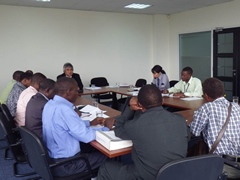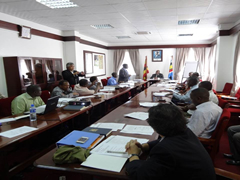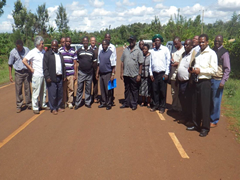Project News
Vol.10 April, 2013
A Study Tour in Uganda & Kenya
 Members for the RMSD Study Tour
Members for the RMSD Study Tour
Exchanging Ideas at JICA-Uganda Office
1. Background
The Prime Minister's Office Regional Administration and Local Government (PMO-RALG) upon recognising this deficiency requested and obtained support from JICA for the preparation of a Road Maintenance System. This system, once in place will be used for planning maintenance programmes for Collector and Feeder Roads throughout the country. As part of the preparation of the Maintenance System, it was agreed that experiences from neighbouring countries of Uganda and Kenya should be utilized.
In this respect, a team of 12 experts from PMO-RALG and the Ministry of Works visited Uganda and Kenya between 7th and 20th April 2013.
2. Objectives of the study tour
The Study Tour focused on the objectives described below:
- Acquisition necessary information to improve rural road maintenance for Tanzania;
- Establishment establish of cooperation between related agencies through site visits to JICA supported Projects in Kenya and Uganda, and sharing experiences;
- Strengthening capacity of counterparts through discussions of guidelines, presentation etc. in those countries.
3. Uganda
In Uganda the study team visited different stakeholders for road maintenance Among them were Ministry (MoWT-Ministry of Works and Transport), Uganda Road Fund URF, Uganda National Road Authority-UNRA, Wakiso DC, JICA- DUR GIS Mapping Project
Lessons learnt were subdivided into four categories as follows:
Policy Issues
- MoWT is responsible for road management policy and provision of related guidelines to the districts.
- There has been a policy shift in the system of maintaining the district roads. The Government was in a transition period of five years of using Force Account while strengthening contracting system.
- The Government has provided equipment which was managed at the Council level and it is making efforts to establish zonal equipment hire pools.
- The Government has prepared and provided districts with road works manuals and guidelines on the force account system.
- There were plans to establish District and Urban Road Authorities.
Planning
- MoWT is responsible for road development and maintenance policies and associated guidelines.
- The Government has long and medium-term development and maintenance plans for the road network managed by local governments.
- All classified roads under the jurisdiction of local governments receive some financing from the Road Fund (this includes Community Roads).
- The Government was establishing a computerized user-friendly planning and management tool to replace the computerized road management tool, RAMPS. The new system faced several challenges.
- All roads including community roads were classified.
- There was inadequate funding for development works
- Road works were financed mainly from Treasury, Development Partners and Road Fund.
Implementation
- Routine maintenance was implemented by:
- Labour based routine maintenance through framework contracts regulated by issuing the monthly site instructions;
- Mechanized routine maintenance.
- We learnt that we share similar problems of lack of quality control equipment at the district level.
- There was a potential threat of availability of local construction materials such as gravel and stones (haulage distance/high costs).
- There were many challenges on the use of the Force Account system:
- Difficulty in procurement of materials and equipment;
- Inadequate staff for supervision;
- Laborers were not easily available particularly in peri-urban environment where there were multi-economic activities.
Monitoring and Evaluation
- Existence of Works and Technical Services Committee enhances monitoring/quality control on works carried out (at sub-counties level).
- Monitoring focuses on works did not deal with other stages of programmes implementation (such as planning, preparation and procurement).
4. Kenya
In Kenya the study team visited different stakeholders for road maintenance. Among them were MoR-Ministry of Roads, KeNHA-Kenya National Highway Authority, KeRRA-Kenya Rural Roads Authority, Muranga Region, Lari DC, JICA-SHEPUP Smallholder Horticulture Empowerment Project.
The following were lesson learnt in Kenya:
Policy issues:
- The Ministry of Roads was responsible for road management policies and related guidelines for all classes of roads with an approximate total length of 176,000 km.
- Roads were classified into three main categories: Main Roads (Class A, B, C, D and E); Urban Roads for the 3 cities; and 46 municipalities and Rural Roads.
- National Roads are managed by KeNHA; Urban Roads by KURA and Rural Roads by KeRRA.
- Road works are implemented through contracting. Force Account was employed for specific purposes.
- Mechanical and Transport Equipment Fund (MTEF) manages available equipment at the regional centers; they are for emergency repairs and hire for private sector.
- There are three main sources of funds for road works; Treasury, development partners; and Road Fund.
- Allocation of maintenance funds is from the Road Fund; 32% of this fund is disbursed equally to the 290 constituencies.
Planning issues:
- The Ministry is responsible for long and medium term plans which reflect the government policies.
- These plans are included in the Ministry Strategic Plan or the Road Sector Investment Plan.
- Roads Authorities issue planning guidelines.
- Maintenance planning is carried out at the constituency level by constituency road committees to ensure appropriate service level of the network and connectivity. A county engineer is available for technical guidance only.
- ARICS is a tool for planning at constituency level.
Implementation:
- Contracting method is widely employed.
- Labour Based Technology is used for maintenance of rural roads wherever technically possible.
- Due to challenges of availability of gravel, low-cost seals are preferred for district and urban roads.
- Some project costs are high due to long haulage distance of construction materials.
- Materials testing and the supervision checklists are tools for ensuring quality outputs.
- Ten laboratories established by KeRRA are operational; efforts are underway to introduce the same at every county.
- Supervision package during implementation is an in-built feature in the project cost.
Monitoring and Evaluation
- Monitoring and evaluation is a separate package in development and maintenance projects; this includes quality control.
- Monitoring and evaluation for maintenance of rural roads is carried out through:
- Frequently Quality Assurance Audits from MoR (HQs);
- Constituency Road Committees;
- Audits from Road Fund;
- Public opinion from beneficiaries.
Generally apart from the above, RMSD Study Team learnt also the following:
- Involvement of communities in planning of road programs at county level;
- Use of labour based methods for job creation and community ownership of the project;
- Application of Force Account for Special Purposes (in this case for establishing unit rate for particular road works);
- Use of private consultants realization of strong supervision;
- Establishment of 10 laboratories owned by KeRRA for quality control is an achievement;
- Use of low cost seals as a long term strategy to minimize maintenance cost and preserve the environment;
- Use of cold binders (emulsions) lime and cement to improve the quality of natural materials used as road pavement layers;
- Involvement of Women as a measure of increasing household income. In the projects women involvement was up to 39%;
- Use of innovative technologies ‘Do-nou’ and ‘cobblestone’ in fixing localized road problems;
- Higher potential of using communities in maintenance of access roads in their community when they are sensitized;
- Contribution of good roads towards the produce farm gate prices;
- Contribution of community roads towards improving productivity and economic development of rural communities.
(Tatsumi Tokunaga/RMSD Project Leader)
 Participants Together with Delegates from MOWT, URF and UNRA Discuss on Overview of Rural Roads Maintenance System
Participants Together with Delegates from MOWT, URF and UNRA Discuss on Overview of Rural Roads Maintenance System
 A group photo between RMSD Study team and Murang`a`s Regional Engineers during a site visit on low volume sealed road
A group photo between RMSD Study team and Murang`a`s Regional Engineers during a site visit on low volume sealed road
- About JICA
- News & Features
- Countries & Regions
- Our Work
- Thematic Issues
- Types of Assistance
- Partnerships with Other Development Partners
- Climate Change / Environmental and Social Considerations
- Evaluations
- Compliance and Anti-corruption
- Science and Technology Cooperation on Global Issues
- Research
- JICA Development Studies Program / JICA Chair
- Support for the Acceptance of Foreign HRs / Multicultural and Inclusive Community
- Publications
- Investor Relations
